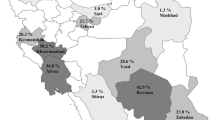Abstract
To determine annual patterns and correlates of nonfatal heroin overdose across 3 years, data were analyzed on 387 heroin users recruited for the Australian Treatment Outcome Study (ATOS), interviewed at 12, 24, and 36 months. A heroin overdose across follow-up was reported by 18.6%, and naloxone had been administered to 11.9%. Annual rates of overdose declined between baseline and 12 months and then remained stable. Previous overdose experience was strongly related to subsequent overdose. Those with a history of overdose before ATOS were significantly more likely to overdose during the study period. In particular, there was a strong association between overdose experience in any 1 year and increased overdose risk in the subsequent year. This is the first study to examine long-term annual trends in nonfatal heroin overdose. While overdose rates declined after extensive treatment, substantial proportions continued to overdose in each year, and this was strongly associated with overdose history.
Similar content being viewed by others
References
Darke S, Degenhardt L, Mattick R. Mortality amongst illicit drug users: epidemiology, causes and intervention. Cambridge: Cambridge University Press; 2006.
Darke S, Mattick R, Degenhardt L. The ratio of non-fatal to fatal overdose. Addiction. 2003;98:1169–1170.
Darke S, Hall W. Heroin overdose: research and evidence-based intervention. J Urban Health. 2003;80:189–200.
Bennett G, Higgins D. Accidental overdose among injecting drug users in Dorset, UK. Addiction. 1999;94:1179–1190.
Best D, Gossop M, Man L, Finch E, Greenwood J, Strang J. Accidental and deliberate overdose among opiate addicts in methadone maintenance treatment: are deliberate overdoses systematically different? Drug Alcohol Rev. 2000;19:213–216.
Darke S, Ross J. Overdose risk perceptions and behaviours among heroin users in Sydney, Australia. Eur Addict Res. 1997;3:87–92.
Darke S, Ross J. The relationship between suicide and overdose among methadone maintenance patients in Sydney, Australia. Addiction. 2001;96:1443–1453.
Darke S, Ross J, Hall W. Overdose among heroin users in Sydney, Australia I. Prevalence and correlates of non-fatal overdose. Addiction. 1996;91:405–411.
Darke S, Williamson A, Ross J, Teesson M. Heroin overdose, treatment exposure and client characteristics: findings from the Australian Treatment Outcome Study (ATOS). Drug Alcohol Rev. 2005;24:425–432.
McGregor C, Darke S, Christie P, Ali R. Experience of non-fatal overdose among heroin users in Adelaide: Circumstances and risk perception. Addiction. 1998;93:701–711.
Ochoa KC, Hahn JA, Seal KH, Moss AR. Overdosing among young injection drug users in San Francisco. Addict Behav. 2001;26:453–460.
Pollini RA, McCAll L, Mehta SH, Vlahov D, Strathdee SA. Non-fatal overdose and subsequent drug treatment among injection drug users. Drug Alcohol Depend. 2006;83:104–110.
Seal KH, Kral AH, Gee L, et al. Prediction and prevention of non-fatal overdose among street-recruited injection heroin users in the San Francisco Bay area, 1998–1999. Am J Publ Health. 2001;91:1842–1846.
Sergeev B, Karpets A, Sarang A, Tikhonov M. Prevalence and circumstances of opiate overdose among injection drug users in the Russian Federation. J Urban Health. 2003;80:212–219.
Stewart D, Gossop M, Marsden J. Reductions in non-fatal overdose after drug misuse treatment: results from the National Treatment Outcome Research Study (NTORS). J Subst Abuse Treat. 2002;22:1–9.
Darke S, Hall W, Heather N, Wodak A, Ward J. Development and validation of a multi-dimensional instrument for assessing outcome of treatment among opioid users: the Opiate Treatment Index. Br J Addict. 1992;87:593–602.
Ware JE, Kosinski M, Keller SD. A 12-item short-form health survey: construction of scales, and preliminary tests of reliability and validity. Med Care. 1996;34:220–233.
World Health Organization Composite International Diagnostic Interview (version 1.1). Vienna: World Health Organization; 1993.
Robins LN, Helzer JE, Croughan J, Ratcliff KS. National Institute of Mental Health Diagnostic Interview Schedule: its history, characteristics, and validity. Arch Gen Psychiatry. 1981;38:381–389.
SPSS inc. SPSS for Windows, 14.0. Chicago: SPSS Inc.; 2005.
Flynn PM, Joe GW, Broome KM, Simpson DD, Brown BS. Recovery from opioid addiction in DATOS. J Subst Abuse Treat. 2003;25:177–186.
Gossop M, Marsden J, Stewart D, Rolfe A. Treatment retention and 1 year outcomes for residential programmes in England. Drug Alcohol Depend. 1999;57:89–98.
Acknowledgments
This research was funded by the National Health and Medical Research Council, and the Australian Government Department of Health and Ageing. The authors wish to thank all participating agencies.
Author information
Authors and Affiliations
Corresponding author
Additional information
Darke, Williamson, Ross, Mills, Harvard, and Teesson are with the National Drug and Alcohol Research Centre, University of New South Wales, Sydney, NSW 2052, Australia.
Rights and permissions
About this article
Cite this article
Darke, S., Williamson, A., Ross, J. et al. Patterns of Nonfatal Heroin Overdose Over a 3-Year Period: Findings From the Australian Treatment Outcome Study. J Urban Health 84, 283–291 (2007). https://doi.org/10.1007/s11524-006-9156-0
Published:
Issue Date:
DOI: https://doi.org/10.1007/s11524-006-9156-0





